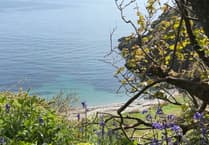Seal pupping season is getting earlier and earlier due to changes in the marine ecosystem.
We have already started to receive calls from the public about seal pups appearing to be stranded or abandoned on our beaches, especially after stormy weather.
We’re on hand to give advice about specific sightings, and we will always investigate a seal that appears to be in distress, but the vast majority of them don’t need any help.
Both the Atlantic Grey seal and the Harbour or Common seal can be found in Manx waters.
In the autumn, females come on to land to give birth to a single pup. Usually they pick remote locations, such as the Calf of Man, although sometimes pups can be seen on the mainland too.
Other spots to see them include Niarbyl, Langness, the Point of Ayre and Maughold Head.
The female leaves her pup while she goes out to sea to hunt for food and so a passer-by may assume the pup has been abandoned.
She will come back to shore every few hours to feed her offspring, and while her pup will rapidly put on the pounds, she will lose about a quarter of her body weight.
After only three to four weeks the pup will weigh about three times its birth weight and will be weaned.
It will then need to live off its fat reserves until it learns to find food for itself.
Brutal as it sounds, the mother seal does not spend time with her pup showing it what to eat and how to feed, and the youngster has to rely on instinct for its survival.
Seal pups tire easily, particularly in stormy weather and rough seas, and they will haul out onto the nearest beach or rocks which then makes them vulnerable to human, and canine, disturbance.
We work closely with Manx Wildlife Trust to assess seal pup strandings and sightings – for valuable advice see its website https://www.mwt.im/news/seals-sake-and-yours.
Unless the pup is visibly seriously injured we always wait for a turn of the tide in anticipation that the pup will return back out to sea on a high tide.
Seals are protected by the Wildlife Act 1990 and so it is illegal to disturb them unnecessarily.
Disturbing a seal or a seal pup ranges from deliberately causing a sleeping or resting animal to raise its head to look at you, to a panicked escape back into the sea.
If the latter response involves hauling off rocks at low tide, there could be a drop of several metres. Falling off rocks like this may injure a seal, and could kill a pup.
The resting seal or pup is conserving energy and being forced to move, or being stressed by the presence of humans or dogs, is a waste of their energy.
In times of limited food they can’t afford to use up valuable reserves, and loss of weight and condition may result in the seal not breeding that year. And at this time of year disturbance can be particularly dangerous because it can result in a female abandoning her pup, which will then starve.
Seal pups might look cute and fluffy, but they can be aggressive and they have a ferocious bite.
They’re also good at ‘playing dead’ and so you must never approach, or touch, one even if you think it’s lifeless – simply observe from a distance of at least 50 metres, ideally 100.
It goes without saying that children and dogs must also be kept well away, and that they must be quiet and calm in order to minimise any stress their presence may be causing the pup.
Unless you have genuine reasons to be concerned for a seal pup’s health, leave it alone. And don’t post images of the pup on social media, especially if its location is easily identifiable from the photographs – you will attract sightseers. We’re incredibly lucky to have these amazing animals in Manx waters and we need to treat them with the respect they deserve.


.png?width=209&height=140&crop=209:145,smart&quality=75)


Comments
This article has no comments yet. Be the first to leave a comment.